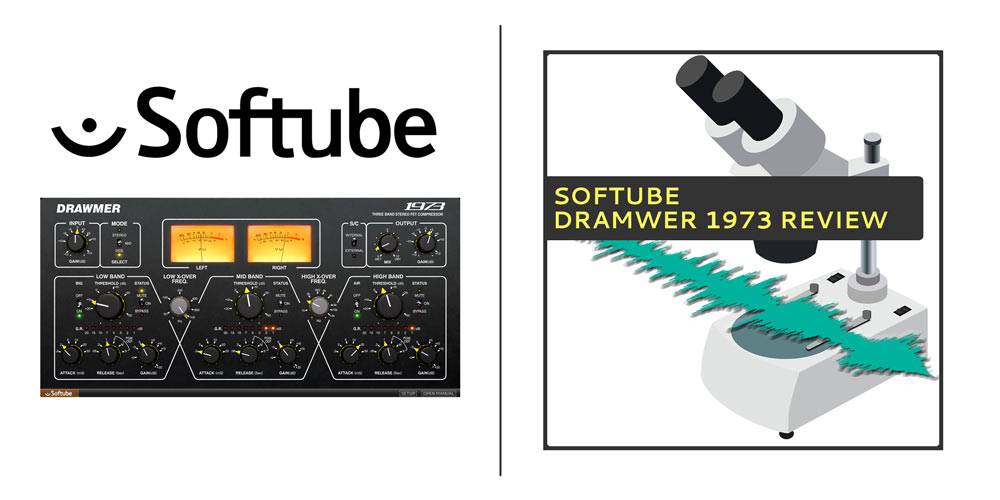Softube Dramwer 1973 Multiband Compressor Review
[cs_content][cs_section parallax=”false” style=”margin: 0px;padding: 10px 0px 0px;”][cs_row inner_container=”false” marginless_columns=”false” style=”margin: 0px auto;padding: 0px;”][cs_column fade=”false” fade_animation=”in” fade_animation_offset=”45px” fade_duration=”750″ type=”1/1″ style=”padding: 0px;”][cs_text]We had the great chance to get our hands on the new Softube Drawmer 1973 plug in to test the compressor in a real live mastering scenario. As there are already several reviews and tests in the internet we did focus on electronic music and tested the drawmer 1973 in the Noizefield studio for several weeks.[/cs_text][x_custom_headline level=”h3″ looks_like=”h5″ accent=”true” class=”cs-ta-center”]Quick start (Attention, Spoiler inside!)[/x_custom_headline][/cs_column][/cs_row][cs_row inner_container=”false” marginless_columns=”false” style=”margin: 0px auto;padding: 0px;”][cs_column fade=”false” fade_animation=”in” fade_animation_offset=”45px” fade_duration=”750″ type=”1/1″ style=”padding: 0px;”][cs_text]To get straight to the point, this compressor is extraordinarily good. It is one of the best compressor plug ins we’ve ever come across and it does sound amazing (If one can say that to a compressor…).[/cs_text][x_image type=”thumbnail” src=”https://www.noizefield.com/wp-content/uploads/2016/06/drawmer_1973.jpg” alt=”” link=”false” href=”#” title=”” target=”” info=”none” info_place=”top” info_trigger=”hover” info_content=””][/cs_column][/cs_row][cs_row inner_container=”false” marginless_columns=”false” style=”margin: 0px auto;padding: 0px;”][cs_column fade=”false” fade_animation=”in” fade_animation_offset=”45px” fade_duration=”750″ type=”1/1″ style=”padding: 0px;”][x_custom_headline level=”h3″ looks_like=”h5″ accent=”true” class=”cs-ta-center”]What is it?[/x_custom_headline][/cs_column][/cs_row][cs_row inner_container=”false” marginless_columns=”false” style=”margin: 0px auto;padding: 0px;”][cs_column fade=”false” fade_animation=”in” fade_animation_offset=”45px” fade_duration=”750″ type=”1/1″ style=”padding: 0px;”][cs_text]Basically the original 1973 is a hardware compressor that is made by Dramwer and surprisingly this unit is relatively new in the market (around 2014) and not one of the classic vintage gears that are usually remade in plug in technology. The Dramwer website claims the original hardware as: “an affordable Three Band Stereo FET Compressor that every engineer will completely appreciate – the 1973″. [/cs_text][/cs_column][/cs_row][cs_row inner_container=”false” marginless_columns=”false” style=”margin: 0px auto;padding: 0px;”][cs_column fade=”false” fade_animation=”in” fade_animation_offset=”45px” fade_duration=”750″ type=”1/1″ style=”padding: 0px;”][x_feature_headline level=”h4″ looks_like=”h5″ icon=”star”]Under the hood[/x_feature_headline][cs_text]The 1973 is a Multi-Band Compressor that splits the frequency spectrum into three bands. Each band has the similar set of controls, except of some specials like the “BIG” switch in the LOW BAND section and the Air knob in the HIGH BAND section. Similar for each band is the STATUS knob to control the mute and bypass for the band, a bigger knob which sets the threshold and three smaller knobs: the attack knob the release knob and a gain knob. Between the thee bands is a frequency knob that selects the crossover frequencies for the crossover filters which operates at 6dB per octave. The low crossover frequency ranges from 50Hz – 1.3kHz and the high crossover frequency ranges from 1kHz – 14kHz. A little different then usual is the threshold knob of each band as the labelling of the scale starts with +20dB and ends clockwise at -30dB. This could be little confusing for younger users as in the digital domain the 0dB represents the maximum value. A low threshold value will do less compression as usual and the higher the value is set the more compression will be applied. A ratio knob that usually adjusts the compression curve and how strong the compression will affect the level above the threshold is not available in the 1973 as the 1973 uses a special soft knee curve which adds the more compression the more input level is applied.[/cs_text][x_image type=”thumbnail” src=”https://www.noizefield.com/wp-content/uploads/2016/06/Compressor_Scheme_02.jpg” alt=”” link=”false” href=”#” title=”” target=”” info=”none” info_place=”top” info_trigger=”hover” info_content=””][cs_text]The BIG switch enables a special mode where the low frequencies appear louder. The same goes for the AIR switch which makes the sound more transparent and “airy”.[/cs_text][/cs_column][/cs_row][cs_row inner_container=”false” marginless_columns=”false” style=”margin: 0px auto;padding: 0px;”][cs_column fade=”false” fade_animation=”in” fade_animation_offset=”45px” fade_duration=”750″ type=”1/1″ style=”padding: 0px;”][x_feature_headline level=”h4″ looks_like=”h5″ icon=”star”]Sidechain[/x_feature_headline][/cs_column][/cs_row][cs_row inner_container=”false” marginless_columns=”false” style=”margin: 0px auto;padding: 0px;”][cs_column fade=”false” fade_animation=”in” fade_animation_offset=”45px” fade_duration=”750″ type=”1/1″ style=”padding: 0px;”][cs_text]It’s possible to use an external sidechain signal. This can be useful in several ways. The most common way especially in electronic music is to sidechain compress the main signal with a kick drum.[/cs_text][x_feature_headline level=”h4″ looks_like=”h5″ icon=”star”]Mid- / Side Compression[/x_feature_headline][cs_text]A very useful feature that even the original Dramwer 1973 doesn’t have, is the possibility to switch the compressor in a mid- side mode (MS). With MS you can compress the mid and the side components of a stereo signal individually. The MS compression is widely used in mastering situations where a wider stereo image is targeted or the mid signal is compressed much harder than the side signal.[/cs_text][/cs_column][/cs_row][cs_row inner_container=”false” marginless_columns=”false” style=”margin: 0px auto;padding: 0px;”][cs_column fade=”false” fade_animation=”in” fade_animation_offset=”45px” fade_duration=”750″ type=”1/1″ style=”padding: 0px;”][x_feature_headline level=”h4″ looks_like=”h5″ icon=”star”]Parallel compression[/x_feature_headline][cs_text]Also parallel compression is easily possible. A simple turn on the MIX know allows a smooth bend between the dry and the wet signal.[/cs_text][/cs_column][/cs_row][cs_row inner_container=”false” marginless_columns=”false” style=”margin: 0px auto;padding: 0px;”][cs_column fade=”false” fade_animation=”in” fade_animation_offset=”45px” fade_duration=”750″ type=”1/1″ style=”padding: 0px;”][x_custom_headline level=”h3″ looks_like=”h5″ accent=”true” class=”cs-ta-center”]The sound[/x_custom_headline][cs_text]During the last couple of weeks the 1973 was used in almost all different situations, whether the 1973 was on the master bus, a drum bus, a single vocal track or on individual drum or synth track. Usually multiband compression is an advanced technique, but the plugin is in even comparison with other multiband compressors very easy to use. It’s limited settings allow a fast workflow which is very useful and important in a modern music production environment. The compressor sounds very modern and fresh. It doesn’t overdo it’s job and even in extrem settings it does sound quite musical. The only thing where we had to twist our mind a bit was the way how the threshold knob works. At least the labelling did confuse us in the beginning. Maybe this could be a feature for the future where the user can define if he wants the oldschool analogue +20dB to -30dB label or a digital 0db to -00dB label. Apart from that the only thing could be to have more attack and release times but this would definitely increase the complexity.[/cs_text][x_feature_headline level=”h3″ looks_like=”h5″ icon=”video-camera”]Watch the 1973 Compressor in action[/x_feature_headline][x_video_embed no_container=”false” type=”16:9″]


